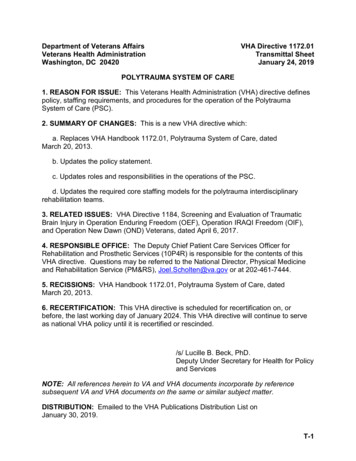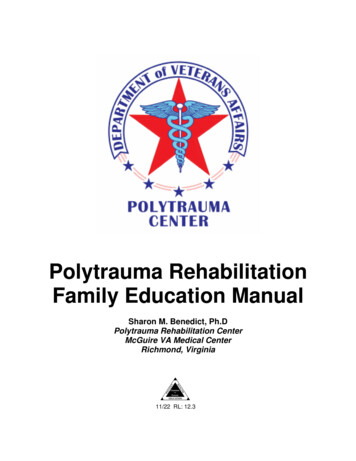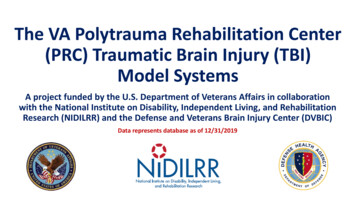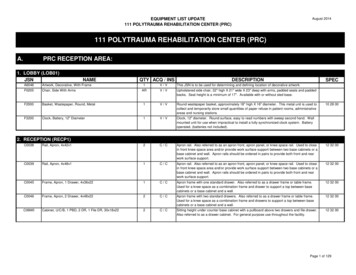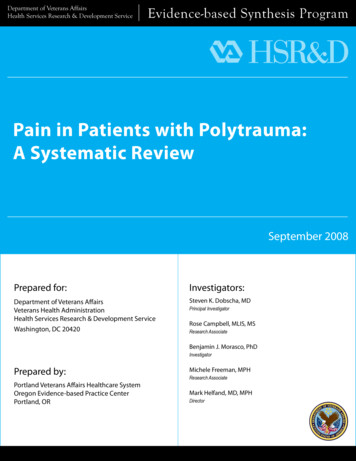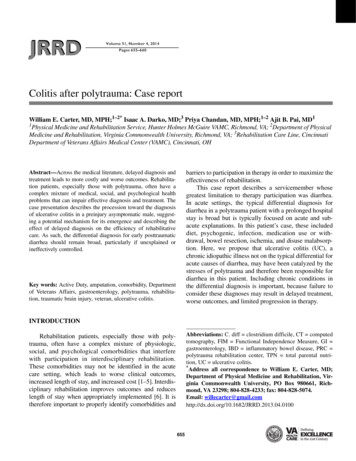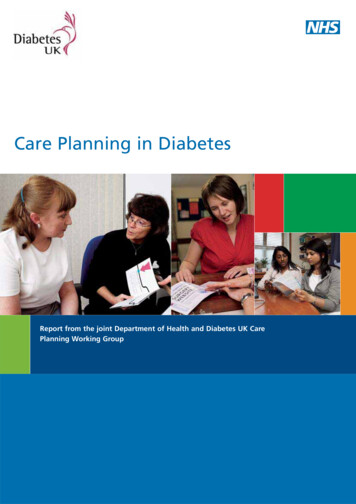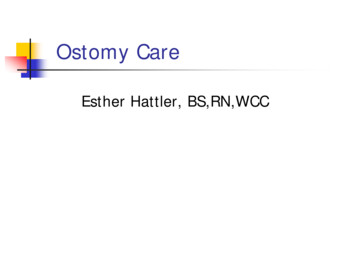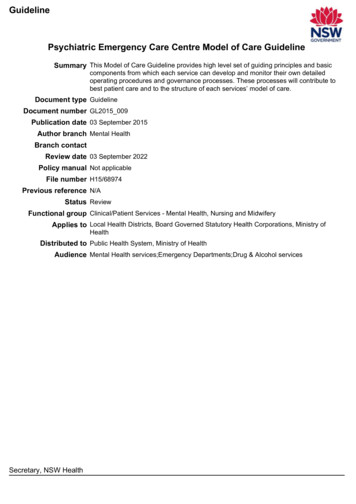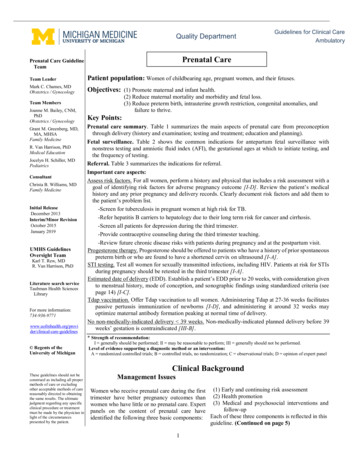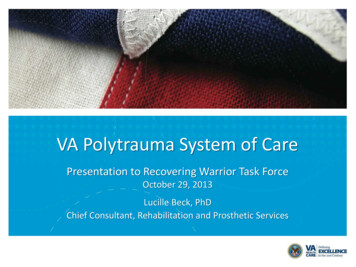
Transcription
VA Polytrauma System of CarePresentation to Recovering Warrior Task ForceOctober 29, 2013Lucille Beck, PhDChief Consultant, Rehabilitation and Prosthetic Services
Inquiry from Task Force Describe the polytrauma system of care from the MTF to thecommunity What type of polytrauma and rehab services will the currentgeneration of Veterans need long term? How prepared is VA to care for the most severely injured? What types of issues are experienced with information andrecords transfer?VETERANS HEALTH ADMINISTRATION2
VA Rehabilitation and Prosthetic ServicesMeeting the rehabilitation and prosthetic needs of Veterans: Providing lifelong support, many with special needs including: Over 2,500 moderate-severe brain injured (Veterans and ServiceMembers) inpatient rehabilitation stays since 2003 38,000 with major limb amputations 21,000 with spinal cord injuries and disorders 50,000 blind and visually impaired Providing advanced care, technologies, and continuityof services for Veterans transitioning from DoD to VAthat are necessary to maximize functionand independenceVETERANS HEALTH ADMINISTRATION3
VA Polytrauma System of Care EvolutionOct 11: 5th PRC / 23rd PNS at San Antonio opens, additional PSCTs (86)Apr 09: Assistive Technology Labs added at Polytrauma Rehabilitation CentersSep 08: Additional Polytrauma Support Clinic Teams (82)Jun 08: Amputation System of Care designated (100 sites)Mar 08: Additional Polytrauma Network Site (22)Jul 07: Polytrauma Transitional Rehabilitation Program initiatedApr 07: VA TBI Screening / Evaluation Program for OEF/OIF Veterans implementedMar 07: 76 Polytrauma Support Clinic Teams, 50 Polytrauma Points of ContactJan 07: Emerging Consciousness Program initiatedJul 06: Polytrauma Telehealth Network establishedDec 05: 21 Polytrauma Network Sites Designated (1 in each VISN)Feb 05: TBI Lead Centers designated as Polytrauma Rehabilitation Centers;VA Polytrauma System of Care established1992: Defense and Veterans Brain Injury Consortium (DVBIC) initiatedVETERANS HEALTH ADMINISTRATION1983: MOU established for VA to provide acute rehab for SCI, blind, amputees to DoD
VA Polytrauma System of Care 110 specialized rehabilitation sites across VA:5 Polytrauma Rehabilitation Centers23 Polytrauma Network Sites (1-2 per VISN)87 Polytrauma Support Clinic Teams (2-8 per VISN)39 Polytrauma Points of Contact DoD/VA Memorandum of Agreement that VA may providerehabilitation services for Service Members with TBI, SCI,Polytrauma, and Amputation PSC locations matched geographic distribution of Veterans andService Members with VA locations of clinical expertiseo Most are from “rural” areas ( 30 miles) surrounding major citiesVETERANS HEALTH ADMINISTRATION
6
Integration of ComprehensiveRehabilitation CareAudiologyProgramCare Management& MilitaryLiaisonsBrain InjuryProgramHearingLossPatientand amsVETERANS HEALTH MentalHealthPainManagementPTSDProgram7
Continuum of Special Programs Transitional Rehabilitation ProgramEmerging Consciousness ProgramPolytrauma Telehealth NetworkAssistive Technology Centers of ExcellenceAdvanced Technology ApplicationsDrivers Training Programs (Simulator/Road)Amputation System of CareBlind RehabilitationMild TBI Screening and Evaluation ProgramVETERANS HEALTH ADMINISTRATION
Key to Success Polytrauma and Blast-Related Injuries Quality EnhancementResearch Initiative (QUERI):o Assessed needs / input of patients, family, in order to develop, evolve,and implement new models of care based on best evidenceo Portfolio includes 40 funded studies, 34 publications associated withQUERI-related grants VA / DoD Collaborationso VA Polytrauma Nurses assigned to Walter Reed and Bethesdao Use of Polytrauma Telehealth Network to transfer patients from ClinicalTeam-to-Clinical Teamo VA staff assigned to military medical centers, treatment facilities, DefenseCenters of Excellence, and DoD Center for Intrepido Military liaisons assigned to Polytrauma Rehabilitation CentersVETERANS HEALTH ADMINISTRATION9
Key to Success Collaboratively developed initiatives benefitting medicine:Emerging Consciousness Care protocolClinical practice guidelines for amputation careClinical practice guidelines for PTSDCommon definition for mild TBI and clinical practice guidelines for mild TBIRevised clinical codes (ICD-9-CM) to improve identification, classificationand tracking of TBIo TBI Screening tool utilized for OEF/OIF Veteranso Uniform training curriculum for family members providing care andassistance to Servicemembers and Veterans with TBIooooo Polytrauma Rehabilitation Centers partnership with TBI Model Systemsto benchmarks VA outcomes with those of national TBIMS Centers OEF/OIF Veterans TBI Health RegistryVETERANS HEALTH ADMINISTRATION10
Polytrauma Rehabilitation Center Inpatients(March 2003 through September 30, 2013)2,735 total patients have received (inpatient) care1,532 (56%) were Active Duty SMs 107 new AD patients in FY131,132 of SMs (74%) were injured in foreign theatre 54 new patients in FY131,203 Veterans 140 new patients in FY13VETERANS HEALTH ADMINISTRATION
Referrals to PRCs for Foreign Theatre Injured(FY2003- FY2013)VA9%OTHER RANS HEALTH ADMINISTRATION*WRNMMC created in Q1 FY12
PRC Discharge for Foreign Theatre Injured(FY2003 – FY2013)PRIVATE FACILITY4%HOME VA8%PTRPDC2% DESTINATION0%MTF23%84% of all patients DC to MTFare considered “Community DC”with FIM score 90VETERANS HEALTH ADMINISTRATIONHOME63%
Current Utilization of PRCs Occupancy rates for FY2013: range from 53% - 88% Length of stay new foreign theatre cases in FY2013: 36.2 daysFY2003 – FY2013:– More severely injured: average 85.7 days LOS– Less severely injured: average 28.5 days LOS About 83% of foreign theatre injured treated in FY2013 have a‘Community Discharge’o 63% to Homeo 20% back to MilitaryVETERANS HEALTH ADMINISTRATION
Polytrauma Telehealth Network Links VA all PSC sites Capacity to link with DoD sites High-resolutionvideoconferencingo Remote clinical provider-to-clinicalprovider consultationo Facilitates patient transfers, carecoordination, discharge planningo Remote evaluation for specializedserviceso Educational resource for providersand familiesVETERANS HEALTH ADMINISTRATION
Sharing of Patient RecordsJANUS Joint Legacy Viewer Web-based Graphical User Interface (GUI) with integrated view of VAand DoD patient electronic health records Improved ability to transition OEF/OIF/OND Wounded Warriors into theVA with stable, reliable access to DoD outpatient records in the AHLTAsystem Improved quality and efficiency of care delivery for Severely WoundedWarriors in the Polytrauma Rehabilitation Centers Health Information Exchange viewer with improved usability ascompared to current systems (e.g., improvements in latency and abilityto match directly to clinical workflows)VETERANS HEALTH ADMINISTRATION16
JANUS Viewer – Current Pilot Sites Audie L. Murphy VA Hospital (STVHCS) North Central Federal Clinic (STVHCS) VA Palo Alto Health Care System Minneapolis VA Health Care System James A. Haley’s Veterans HospitalVETERANS HEALTH ADMINISTRATION Hunter Holmes McGuire VA MedicalCenter Alaska VA Healthcare System Joint Base Elmendorf-Richardson Hospital Walter Reed National Military MedicalCenter17
Continuum of Integrated HealthcareTrauma CareSurgicalRehabilitationInpatient - ImmediateInpatient – OngoingMedicalOutpatient CareEvaluation mmunityRe-entry – ResidentialTransitional/CommunityRe-entry - Day ProgramLifetimeCommunity CareSupported LivingVocationalEducationalDay ActivitySupport GroupsSkilled NursingOutpatient CareTotal CareNeurobehavioralOutpatient CareFamily SupportCase ManagementBenefits ManagementMedical Information ManagementVETERANS HEALTH ADMINISTRATION18
Polytrauma Case Management All patients receiving rehabilitation services within PolytraumaSystem of Care are assigned a Polytrauma Case Manager (PCM) 234 PCMs with caseloads distributed as follows:o 1 PCM for every 6 PRC inpatients - provide 24 / 7 coverageo 1 PCM for every 10 inpatients in Polytrauma Transitional Rehabilitation Programo PCM for patients at Polytrauma Network Sites and Polytrauma Support ClinicTeams, based on case mix and geographic region (rural versus urban) Specialty case management includes:ooooCoordination of servicesOngoing evaluation of rehabilitation, psychosocial needsFamily education and support servicesPartnership with other VA and DoD case managers to assure continuity in caremanagement from battlefield to homeVETERANS HEALTH ADMINISTRATION19
Long Term ( 5 Years) Needs after TBILiterature Review of Civilian Experience Mental Health care: 15-50 %General Medical care: 100%Medical Rehabilitative Services: 0-100%Vocational Rehabilitation (supported employment): 20-40%Access to Assisted Living (for placement or respite): 5%Community Living Center / Nursing Home care: 5%VETERANS HEALTH ADMINISTRATION
Combat-Associated mTBI Long Term Needs(Anticipated from Literature VA Experience) Long-term access to Mental Health care: 50%Long-term access to Primary Care: 100%Long-term access to Medical Rehabilitative Services: 10%Vocational Rehabilitation (supported employment): 50-70%Access to Assisted Living (for placement or respite): 1%Community Living Center / Nursing Home care: 1%VETERANS HEALTH ADMINISTRATION
Addressing Long Term Services in PSCVA initiatives include: Oct 2008: VA Geriatrics and Extended Care PolytraumaRehabilitation Task Force Jun 2009: Polytrauma Rehabilitation and Extended CareWorkgroups Oct 2012: Polytrauma Lifelong Care Summit Ongoing:o VHA Steering Committee Long Term Support for Seriously InjuredYounger Veteranso VHA Advisory Committee on Care for Veterans with TBIVETERANS HEALTH ADMINISTRATION22
Addressing Long Term Services in PSCVHA continually defines, develops, and implement lifelong carestrategies for severely injured patients, such as: Caregiver Services (respite options, etc) Residential Care Options (Assisted Living for TBI Pilot) Staged Restorative Program (inpatient admissions for re-evaluations, periodicrehabilitation, family training) Enhancing the transition to home (home-based primary care, securemessaging, home clinical video telehealth) Lifetime Care Needs (PACT collaborations for Veterans with persistentsymptoms or functional deficits after completing rehabilitation) Vocational Rehabilitation (Supported Employment) Long Term Institutional Care (Community Living Centers, Medical Foster Home)VETERANS HEALTH ADMINISTRATION23
Challenges Varying waiver requirements across TRICARE regions toauthorize VA care Continuity of care for former Service Members that are neverreferred or identified to VAVETERANS HEALTH ADMINISTRATION24
VETERANS HEALTH ADMINISTRATION25
VA Polytrauma System of Care OEF/OIF/OND Service Members are eligible for care within VA for5 years after service ( 55% of eligible OEF/OIF/OND Veteransutilize VA services compared to 45% of all other Veteran groups) In Fiscal Year 2013:o 50,516 unique Veterans were served in PSC (outpatient) clinicso 1,381 uniques patients were treated in PSC inpatient units, of which asmany as 67% were Service Members comprised in a given weekVETERANS HEALTH ADMINISTRATION
PSC AccomplishmentsFY2005 - FY201327 More than 2,700 inpatients received PRC (inpatient) care More than 570 patients received PTRP (residential) care afterinpatient services More than 183,000 unique individuals treated in PSC(outpatient) clinicso More than 980,000 total PSC (outpatient) encounters More than 3,400 telehealth encounters More than 760,000 OEF/OIF Veterans screened for TBI More than 107,000 Comprehensive TBI EvaluationsVETERANS HEALTH ADMINISTRATION
Polytrauma Rehabilitation Centers Five Level 1 medical centers providing the highest echelon ofcomprehensive medical and rehabilitative services (inpatient /outpatient) for the most complex and severely injured:o 12-18 inpatient bed unit providing acute interdisciplinary evaluation, medicalmanagement, and rehabilitation (70 beds total)10 inpatient bed residential Transitional Rehabilitation Program (50 beds total)Emerging Consciousness Program (15 beds total)Assistive Technology Lab oooNational VA leaders in polytrauma / TBI providing consultation, medicaleducation, research, and program development for PSCAccredited by Commission on Accreditation of Rehabilitation Facilities(CARF) for inpatient TBI and general rehabilitationCollaborate with DVBIC and national TBI Model Systems projectVETERANS HEALTH ADMINISTRATION
Polytrauma Network Sites 23 regional Level 2 medical centers providing full range ofcomprehensive follow-on medical and rehabilitative services(inpatient and outpatient) for patients recovering from polytraumaand TBI (1-2 per VISN):o Develop and support patient’s rehabilitation plan throughcomprehensive interdisciplinary, specialized teamo Serve as resource and coordinate services for TBI and polytrauma acrossVISN (VHA, DOD, private sector) VISN leader for polytrauma/TBI consultation, education, monitoringoutcomes, and program development for system of care Accredited by CARF for inpatient general rehabilitation (300 inpatientbeds available)VETERANS HEALTH ADMINISTRATION
Polytrauma Support Clinic Teams 87 Level 3 medical centers with dedicated outpatientinterdisciplinary teams of rehabilitation specialists Provide specialty rehabilitation care closer to homeo Evaluate and develop individualized treatment plano Provide interdisciplinary rehabilitation care and long-term management ofpatients with rehabilitation needso Coordinate clinical and support services for patients and families Conduct comprehensive evaluations of patients with positive TBIscreens, develop and implement rehabilitation and communityre-integration plansVETERANS HEALTH ADMINISTRATION
Polytrauma Point of Contact Designated at 39 medical centers without specializedrehabilitation teams Designated VA primary care staff member knowledgeable in thePolytrauma System of Care Coordinate case management and referral within PolytraumaSystem of Care Knowledgeable of rehabilitation services provided within localcommunity, and facilitates referral for such services as necessaryVETERANS HEALTH ADMINISTRATION
Transitional RehabilitationPolytrauma Transitional Rehabilitation Program Located at each PRC site, linked in with local and regional militarytreatment facilities 10-20 beds for extended stay rehabilitation (1-6 months) Focus on community reintegration and vocational rehabilitation Additional specialized treatment and program support providedas necessary to include:oooooPTSD servicesSubstance abusePain managementDrivers Training RehabilitationVocational RehabilitationVETERANS HEALTH ADMINISTRATION
Polytrauma Transitional Rehabilitation ProgramFY2009-FY13Average Length of StayAverage Age70.2 days34.6520 UniquePatientsOEF/OIFFemale26.0%5.0%VETERANS HEALTH ADMINISTRATION33Source: Treatment Specialty Code CubeTreatment Specialty Code 82 @ PRC FacilitiesData pulled 10/21/13
Assistive Technology (AT) Centers34 Comprehensive AT Teams established at 5 PRC siteso Rehabilitation Engineerso RESNA-certified therapists– Cognitive Therapists– Mobility Therapistso Collaboration with U Pitt Center for Assistive Technologyo CARF preparation underway at all siteso Uniform templates for all assessments and treatments Virtual consultation through telehealth across PSC Equipment and services available to any Veteran with needVETERANS HEALTH ADMINISTRATION
Specialized EquipmentAssistive TechnologyBalance/VestibularEye GazeDriving SimulatorAssisted EatingErigoLaser cane
Emerging Consciousness Program Emerging Consciousness Programoooo2-4 beds at each PRCCommon assessment and management protocolsLinked with academic centers who are leaders in DOCEmbedded Epilepsy Centers of ExcellenceVETERANS HEALTH ADMINISTRATION
Emerging Consciousness Program Outcomes37Outcomes of the VHA Emerging Consciousness:o 166 patientso Consecutive admissions at 4 PRCs 2003-2011o Main outcome - emergence to consciousness based on:––––Coma Recovery Scale - RObject Use (feeding)Communication (responding to commands)Rancho 3 or highero Emergence from coma in 70% blast TBI, 85% non-blast TBIand 60% anoxic BIo Of those who emerge, 75% do so by 4 months post-injuryVETERANS HEALTH ADMINISTRATION
Traumatic Brain Injury (TBI) from GWOT 7-12% of OEF-OIF-OND Veterans who received medical care inthe VA have confirmed TBIo 60,000 total (of 750,000 screened)– 95% mild– 5% moderate-severe (2,500-3,000) 73% of Veterans with symptomatic mild TBI also have mentalhealth diagnosis, most commonly Posttraumatic Stress Disorder 90% also have either PTSD or chronic pain disorderSource: ning-eval.pdfVETERANS HEALTH ADMINISTRATION
Concussion CoachConcussion Coach is a mobile phoneapplication for Veterans and Servicemembers who experience symptoms thatmay be related to brain injuryIt can be used as a stand-alone educationand symptom management tool, or toaugment face-to-face care with ahealthcare professionalCompleted Beta testing and pendingreleaseVETERANS HEALTH ADMINISTRATION
Ongoing Polytrauma Education Veterans Health Initiative: TBI Independent Study Courseo 200 page handbook-based course, released April 2010o Web based course launched February 2011– Completed by over 19,500 providerso Developed by VA PM&RS experts, in collaboration with colleagues fromMental Health, Primary Care, Pharmacy, DVBIC, and academia.o brain-injury-vhi.pdf More than 50 multimedia presentations available on VA websitefrom VA and DoD Frequent live presentations available via satellite broadcasts TBI ‘mini-residencies’ offered at Polytrauma Network SitesVETERANS HEALTH ADMINISTRATION
Amputation System of Care Comprehensive rehabilitation system to care for Veterans andActive Duty Servicemembers with amputations transitioning tothe VA. Integrated with PSC to leverage skills with care needs. Regional Amputation Centers (7) Inpatient, outpatient, prosthetics, assessment Polytrauma Amputation Network Sites (15) Outpatient, prosthetics, assessment Amputation Clinic Teams (100) Assessment, outpatient Amputation Points of Contact (30) Primary care, case managementVETERANS HEALTH ADMINISTRATION
Key VA / DoD Partnerships VA is a collaborative strategic advisor and member of:––––––Joint Executive Committee and Health Executive CommitteeDoD/VA Interagency Care Coordination CommitteeJoint Task Area Steering Committee for Blast-induced Brain Injury StudiesDoD Joint Program Committees for PTSD and TBIDoD Centers of Excellence Oversight CommitteeRecovering Warrior Task ForceVETERANS HEALTH ADMINISTRATION42
Polytrauma Rehabilitation Center Inpatients (March 2003 through September 30, 2013) 107 new AD patients in F
